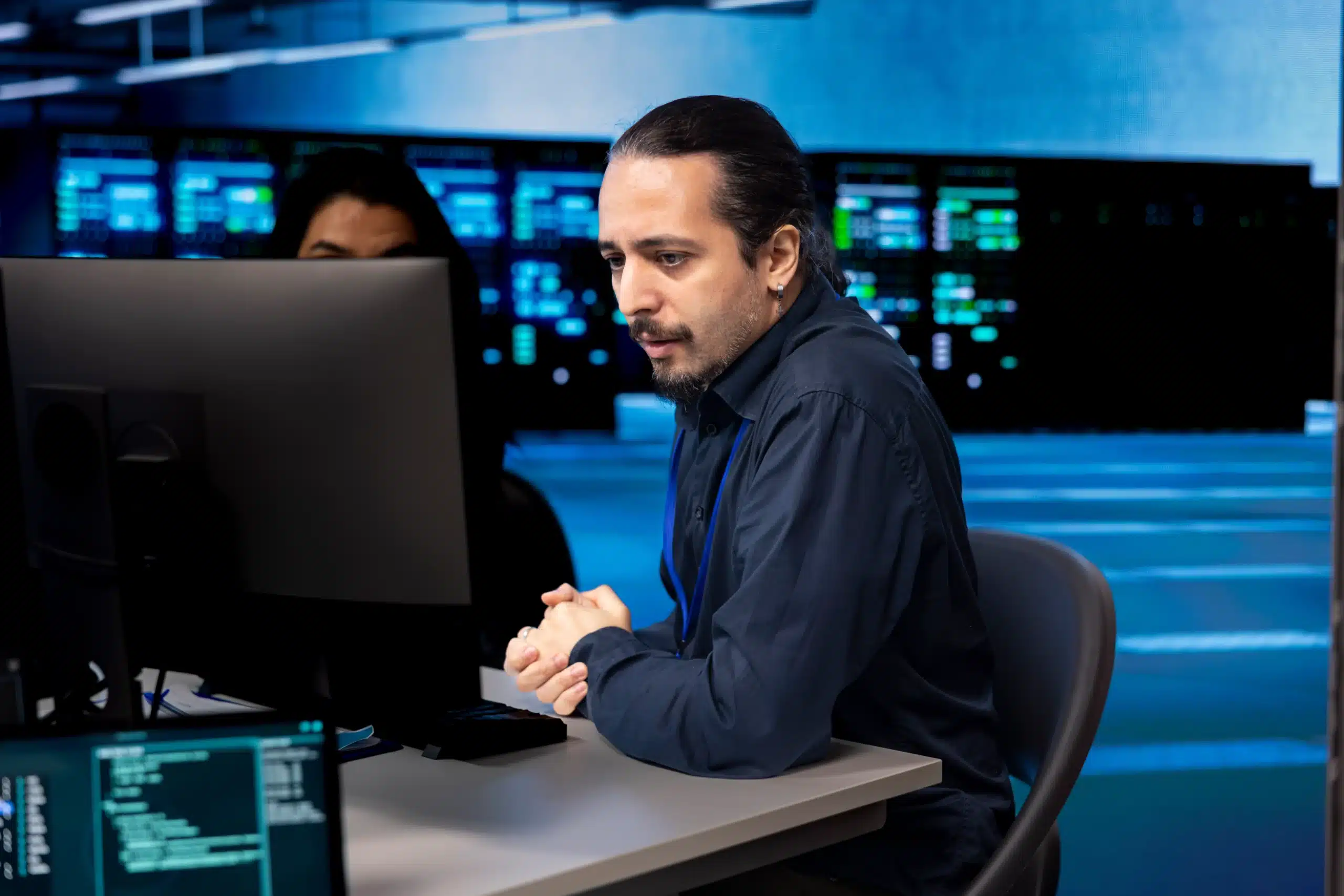Imagine waking up to find your company's most sensitive data stolen overnight. Every second counts when hackers are lurking in your network.

Are you watching your digital doorways 24/7? Most businesses think firewalls are enough. They're wrong. Today's cyber threats move at lightning speed, and traditional security measures can't keep up.
Ready to protect your business with advanced cloud security solutions? Contact our cybersecurity experts to implement comprehensive monitoring systems that detect threats before they cause damage.
What Makes Cybersecurity Monitoring Essential
Think of security monitoring as your digital security guard. It never sleeps, never takes breaks, and watches every corner of your network. This continuous process observes your systems for suspicious activities, unauthorized access, and potential threats.
Without proper monitoring, attackers can hide in your network for months. Studies show hackers stay undetected for an average of 207 days. That's plenty of time to steal everything valuable.
The Hidden Costs of Poor Monitoring
- Financial losses: Data breaches cost companies $4.22 million on average
- Reputation damage: Customer trust takes years to rebuild
- Compliance penalties: Regulatory fines can reach millions
- Business disruption: Downtime kills productivity and revenue
Core Components of Effective Security Monitoring
SIEM Solutions: Your Command Center
Security Information and Event Management systems collect data from across your network. They spot patterns that humans might miss. Modern SIEM tools use machine learning to reduce false alarms and speed up threat detection.
Key benefits:
- Real-time threat analysis
- Automated incident response
- Compliance reporting
- Centralized log management

Network Traffic Analysis
Your network tells a story. Normal traffic has patterns. When something changes, that's your first warning sign. Network monitoring tools track:
- Unusual data transfers
- Suspicious login attempts
- Malware communications
- Unauthorized device connections
Endpoint Detection Systems
Every device on your network is a potential entry point. Laptops, phones, servers, and IoT devices need constant watching. Endpoint monitoring catches threats at the source before they spread.
Essential Cybersecurity Monitoring Tools
| Tool Type | Primary Function | Best For |
|---|---|---|
| SIEM Platforms | Log analysis and correlation | Large enterprises |
| EDR Solutions | Endpoint threat detection | Device protection |
| Network Monitors | Traffic analysis | Network security |
| Vulnerability Scanners | Weakness identification | Risk assessment |
Top-Rated Security Tools
Enterprise Solutions:
- SentinelOne for AI-powered detection
- Splunk for data analytics
- CrowdStrike for endpoint protection
Mid-Market Options:
- LogRhythm for SIEM capabilities
- Darktrace for AI monitoring
- Rapid7 for vulnerability management
Need help choosing the right monitoring solution for your business? Let our security specialists guide you through selecting and implementing the perfect cybersecurity monitoring setup.
Implementation Strategy That Actually Works

Step 1: Inventory Your Assets
You can't protect what you don't know exists. Create a complete list of:
- All connected devices
- Software applications
- Data repositories
- Network access points
Step 2: Identify Critical Data
Not all information needs the same protection level. Focus monitoring resources on:
- Customer personal data
- Financial records
- Intellectual property
- System credentials
Step 3: Set Monitoring Baselines
Establish normal activity patterns. This helps distinguish real threats from everyday operations. Track:
- User behavior patterns
- Network traffic volumes
- Application usage times
- System performance metrics
Step 4: Create Response Procedures
Speed matters. The faster you respond, the less damage occurs. Develop clear procedures for:
- Threat escalation paths
- Emergency contact lists
- Isolation protocols
- Recovery procedures
Advanced Monitoring Techniques
AI-Powered Threat Detection
Artificial intelligence revolutionizes security monitoring. Machine learning algorithms analyze massive data volumes in real-time. They spot subtle attack patterns that traditional tools miss.
Benefits of AI monitoring:
- Faster threat identification
- Reduced false positives
- Predictive threat analysis
- Automated response capabilities
Behavioral Analytics
Modern threats often look legitimate. Behavioral analytics spots the difference between normal and suspicious activities. It tracks user patterns and flags unusual behavior.
Zero Trust Architecture
Never trust, always verify. This approach assumes every connection is potentially dangerous. Continuous verification happens at every access point.
Overcoming Common Monitoring Challenges
Data Overload Problem
Security tools generate enormous amounts of data. The key is focusing on actionable intelligence rather than raw volume. Use automation to filter noise and highlight real threats.
Skills Shortage Solutions
Finding qualified security professionals is tough. Consider:
- Managed security services
- Automated monitoring tools
- Staff training programs
- Outsourced security operations
Budget Constraints
Start with essential monitoring capabilities. Prioritize based on your highest risks. Cloud-based solutions often cost less than on-premises systems.
Ready to implement cost-effective cybersecurity monitoring? Schedule a consultation to discover budget-friendly solutions that deliver enterprise-level protection.
Measuring Monitoring Success
Track these key metrics:
- Mean Time to Detection (MTTD): How quickly you spot threats
- Mean Time to Response (MTTR): How fast you react to incidents
- False Positive Rate: Percentage of incorrect alerts
- Coverage Percentage: How much of your network is monitored
Your Next Steps to Better Security
Effective monitoring isn't optional anymore. It's survival. Cyber threats evolve daily, but smart monitoring keeps you ahead of attackers.
Start with these immediate actions:
- Audit your current monitoring capabilities
- Identify the biggest security gaps
- Choose monitoring tools that fit your needs
- Train your team on threat recognition
- Test your incident response procedures regularly
The best time to implement comprehensive monitoring was yesterday. The second-best time is right now. Don't wait for an attack to realize your security gaps.
Remember: Prevention costs less than recovery. Invest in robust monitoring today to avoid devastating losses tomorrow.












